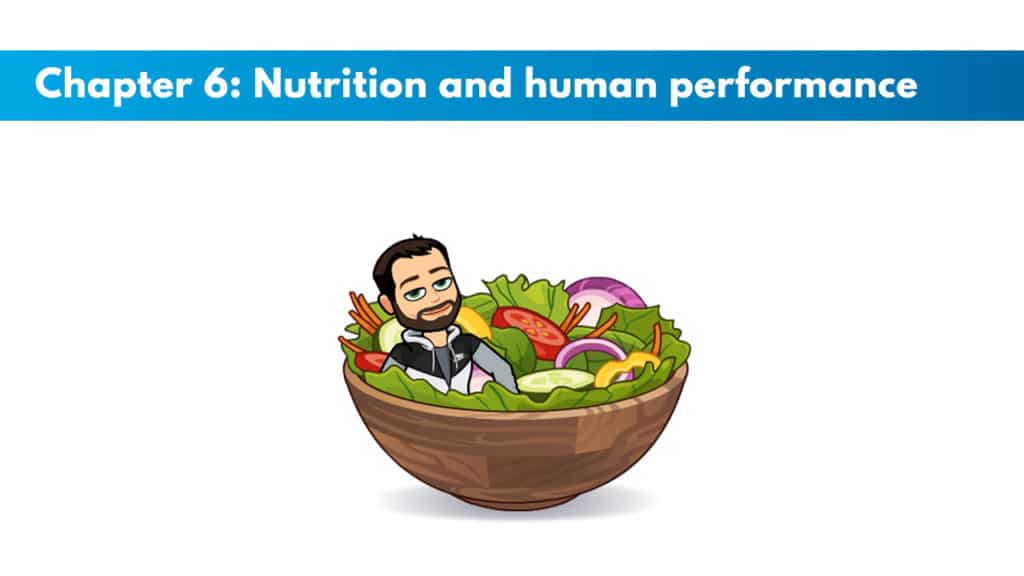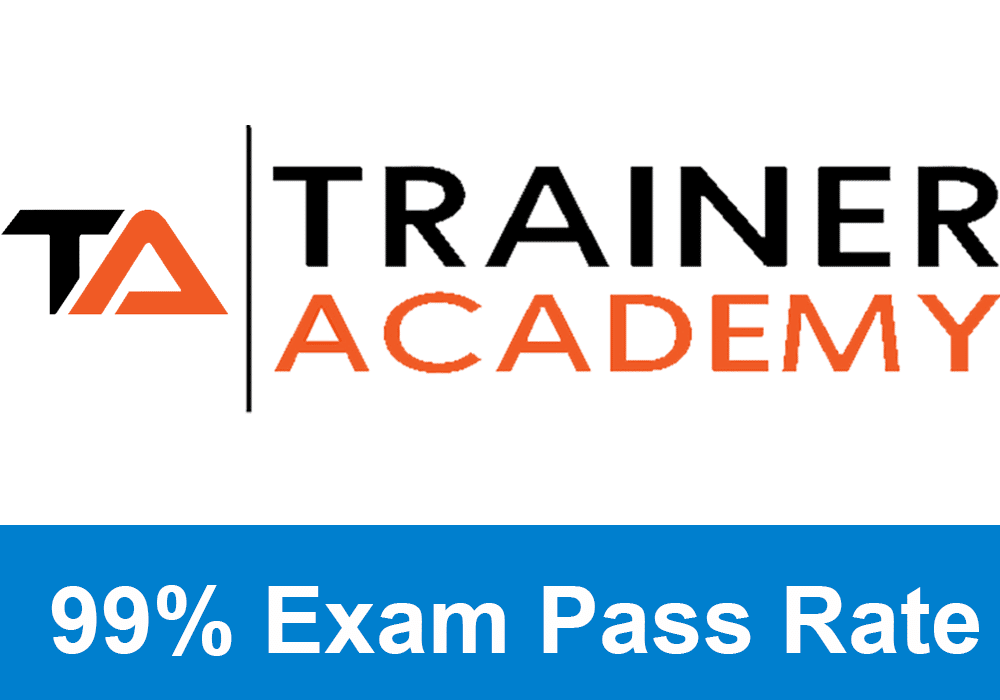
Get your copy of the ACSM CPT exam cheat sheet. It helps immensely for studying for the exam.
My PTP students report cutting their ACSM study time and effort in half with Trainer Academy.
Benefit from the Exam Pass Guarantee and Retake Fee Guarantee. Plus, take advantage of my current discount code PTPJULY for 35% off the MVP Program (Ends July 17th, 2025).
Try it out for free here to see if it’s right for you, or read my detailed review for further insights.
Chapter Objectives:
- Know the different functions of carbs, proteins, and fat for both health and performance.
- Learn vitamin and mineral roles for health and performance.
- Know the importance of being hydrated, keeping up healthy and achieving optimal performance.
- Understand the elements that are essential to energy balance and its relationships with managing weight, body composition, and performance.
- Know the issues related to nutrient supplementation and the strategies for knowing the circumstances in which some supplementation is appropriate.
- Know the issues relating to eating and performance, travel, precompetition meals, nourishment in competition, and post competition replenishment.
Scope of Practice
For most states in the united states, the profession of dietetics is regulated by the law.
The practice is typically only done by registered dieticians with the proper academic degree and certification, and licenses.
Trainers should seek out dieticians to help their clients by referring them. The trainers need to know when to refer clients to these professionals.
Trainers in terms of nutrition should really only teach the basics and fundamentals of nutrition and let the clients make the decisions. Trainers also need to be aware of bad eating habits and disorders that clients may have when they come to them.
Essential Nutritional Concepts
Nutrients
These give the muscles, organs, and bones energy for working, repairing tissues, and developing new tissues. When a client is well-nourished, they have better disease resistance, and the function of the cardiovascular system is enhanced. The clients will also have more likeliness for growing and building muscle and skeletal tissues.
We have six classes of nutrients. These are carbs, proteins, fats, vitamins, minerals, and water. As trainers, we should not teach the clients to consider one nutrient class more important than any other.
With the trainer’s help, the client will have the proper balance of these nutrients in their diet.
People need to get a wide variety of foods to ensure that they get the optimal amount of nutrient exposure.
Clients should know that there is a lot of misinformation and a lack of credible sources of scientific evidence for a lot of nutrition in the fitness world. A lot of it relies on this placebo effect.
Nutrients that provide energy
Meeting energy needs or optimal weight and body composition
The weight and energy intake relationship is simple. When someone takes in more energy than they expend, the excess energy will be stored, and their weight will increase. When someone takes in less energy than they need, their weight will drop somehow.
The recommendation for energy intake and the desire to gain weight is to intake 300 – 400 extra calories. And the same is true for those that want to decrease their weight. We would decrease our energy intake by 300 – 400 calories here.
When we eat frequent, smaller meals, we see these benefits:
- Our metabolic rate is changed.
- We have a lower body fat and weight when we are on higher calorie diets.
- There is a better tolerance for glucose and the response of insulin.
- Stress hormone production is reduced.
- Muscle mass is maintained better.
- Physical performance improves.
Some problems with severe deficits in energy intake:
- Stores of carbohydrates are tough to maintain.
- Lean muscle mass problems.
- The metabolic rate is lowered.
- Nutrient needs are difficult to meet.
- The risk of injury is increased.
Carbohydrate
Carbs come in many different forms and those forms have different outcomes nutritionally. There are some carbs that we are not able to digest.
Exclusive PTP CPT Offers |
||
|---|---|---|
Most Popular Cert | Best Online NCCA Cert | Best Study Materials |
Gold Standard Cert | A Good Option | Best CPT for you?  |
The recommended carbs range from 3 – 18 grams per kilogram of body weight.
Functions of Carbohydrates
They are used for providing energy. Seen as the preferred fuel source for humans.
Sparing protein. This is the preferred fuel source aspect. The body doesn’t have to use proteins when it has carbs.
Fat oxidation. Carbs are needed for fats to be burned.
Acts as parts of other compounds.
Energy storage.
Types of Carbohydrates
Simple carbs: These are our sugars like glucose, fructose, galactose, sucrose, lactose, and maltose.
Polysaccharides: These are carbs with many molecules of sugars that are all connected. These are digestible and indigestible, depending on what they are. Dietary fiber is a cab that cannot be digested but serves a purpose in the diet due to it lowing fat and cholesterol absorption, improving blood sugar control, and reducing colon cancer and heart disease risks.
The Glycemic Index
This is used to measure the carbs and their effect on blood sugar levels. Foods are essentially compared to the ingestion of glucose, which is known to have a value of 100 in this index. If foods have a lower glycemic index, they will maintain blood sugar levels, avoid any excessive insulin response, and encourage fat production while keeping people feeling better for longer periods.
Protein
These complex compounds are made of amino acids containing nitrogen, unlike any other nutrient. Proteins constantly are broken down and changed.
Nonathletic adults require about 0.8 grams per kilogram of body weight.
Functions of Protein
- Synthesis of enzymes and proteins.
- Nutrient transportation to the proper locations.
- Energy source when the body needs it.
- The production of hormones.
- Fluid balancing.
- Acid base balancing.
- The maintenance and growth of the tissues of the body.
- They are used to synthesize nonprotein, nitrogen containing compounds.
Protein Quality
This is determined by how many essential amino acids are in the source. Essential amino acids are the ones that we are not able to produce in our bodies, so we must obtain them in our diets. Most foods have both essential and nonessential amino acids.
There is an emphasis in many diets put on protein, but a lot of the time, it is too excessive than the real need of the body.
Fat
Many people think that higher intakes of fats will enhance performance, but the general healthy range of fats to be taken in is between 20 and 35% of total calories.
Functions of Fat
- Fat is an energy source for the body.
- It provides insulation for us in times of extreme temperature.
- It is used to cushion from concussive forces.
- Fats are used for satiety control.
- Fat gives flavor to our foods.
- A lot of essential nutrients to be discussed later in the chapter are carried by fat.
Classifications of Fat
Fats and oils: these are solid when at room temperature.
Triglycerides, diglycerides, and monoglycerides: the most common dietary fat and oil is triglycerides.
Short, medium, and long chain fatty acids.
Polyunsaturated fatty acids.
Monounsaturated fatty acids.
Saturated fatty acids.
Exclusive PTP CPT Offers |
||
|---|---|---|
Most Popular Cert | Best Online NCCA Cert | Best Study Materials |
Gold Standard Cert | A Good Option | Best CPT for you?  |
Low-density lipoproteins.
High density lipoproteins.
Vitamins
The vitamins are essential for our body’s reactions to occur. By eating a wide variety of food and many fresh veggies and fruits, we can ensure we get sufficient vitamins in our diet. The dietary reference intake on our labels gives percentages based on the average diet.
Water-soluble Vitamins
These are the vitamins that the body only keeps in very limited storage, like vitamins B and C. They are associated most with carb foods like fruits, bread, cereal, and veggies.
Fat-soluble Vitamins
These vitamins are only delivered with the presence of fats and oils. Vitamins A and D are common examples, and they are carried within the fat component of milk.
Minerals
These inorganic substances are used for water balance, the stimulation of nerve impulses, balances of acid-bases, and energy reactions. Iron, zinc, and calcium are some of the more important ones to name a few. Iron and zinc are known for their use in energy metabolism, and calcium for their importance in skeletal repair and maintenance.
Fluid and Hydration
Water takes the nutrients we take into the cells and carries the waste away. It is also a lubricant for the body and assists in maintaining our temperature.
We lose water when we breathe, through the skin, in our urine, sweat, and our feces.
Meeting Fluid Needs
The benefits of staying fueled and hydrated:
- Lessened heart rate increase.
- Lessened increases in the core body temperature.
- Cardiac stroke volume and cardiac output improvements.
- Skin blood flow improvements.
- Maintaining better volumes of blood.
- Net muscle glycogen usage is reduced.
The fluid intake recommendations are these:
- Drink to match your loss of sweat.
- Drink before being thirsty.
- Check the color of urine to try to keep it clear or pale yellow.
- Large volumes of fluid in a short time increase gastrointestinal distress.
- Hyponatremia may occur with large amounts of fluid being taken in when sodium is absent.
- Fluids need to be cool, taste good and be available easily.
Fluid Consumption Guidelines
Fluid is important, but so is the type of fluid consumed. Most studies say that fluids with 6 – 8% carbs and 100 – 200 mg of sodium per cup, like the sports beverages we see, are best for sports and activities.
Water Versus Sports Drinks
Water doesn’t have flavor or electrolytes, and it causes you to want to drink more. Thus, it is good in this sense.
Water doesn’t have energy, and sports drinks do so that they will prevent early fatigue and decreasing performance.
Sodium in sports drinks maintains blood volume.
Dietary Supplements and Ergogenic Aids
Dietary Supplements
These are used to intervene in dietary deficiencies.
Ergogenic Aids
These are used for improved performance, regardless of if there is any known deficiency.
Special Conditions
Some special conditions include extreme environments and vegetarianism.
The risk of dehydration exists in both hot and cold situations. For hot areas, the loss is from sweat and dissipating heat, and then for the cod areas, we still lose a lot of fluid through our breathing. We must do our best in those situations to maintain a good body temperature and to hydrate properly.
We must meet the nutritional requirements mentioned throughout this chapter for vegetarian athletes. Some things that might lack in this diet are zinc, protein, vitamin B, and energy.
Practical Considerations
One day before Competition
We should avoid foods that are high in fat.
Eat a solid breakfast.
Lunch should be sandwiches, pasta or rice.
Something similar should follow for dinner, and for dessert, yogurt, and fruit.
Drink extra fluid throughout the day.
Immediately before Exercise or Competition
Make certain to have sufficient energy for the entire bout of exercise.
Stop any feelings of hunger.
Be fully hydrated.
Avoid high fiber or gas causing foods.
Drink a lot of water 4 hours before, and then a good amount 10 – 20 minutes before.
During Exercise or Competition
If exercise is less than 45 minutes, then do not consume carbs, but when over that time, small amounts of carbs are needed. Solid foods should even be consumed if going for 1 – 2.5 hours.
After Exercise or Competition
1.0 – 1.2 grams per kilogram for the first 4 – 6 hours will promote muscle glycogen recovery.
Typically, 200 – 400 calories immediately after activity, and then 200 300 the next hours.
People should drink at least 20 ounces of fluid per pound and lost body weight.
Eating on the Road
We should pack foods that are nutrient dense.
Pick up basics when you get to the destination.
When eating out, always go with healthier options.
Understanding a Food Label (From the U.S. Food and Drug Administration, Center for Food Safety and Applied Nutrition)
Serving Size
The typical one is in units like cups or pieces. This is how much you should eat at once to be considered a serving.
Calories
The unit of measure for how much energy is in the food, or sometimes the serving of the food.
Percent of Daily Values
This is how much is recommended for the upper limit of the discussed nutrient.

 Have a question?
Have a question? 



Tyler Read
PTPioneer Editorial Integrity
All content published on PTPioneer is checked and reviewed extensively by our staff of experienced personal trainers, nutrition coaches, and other Fitness Experts. This is to make sure that the content you are reading is fact-checked for accuracy, contains up-to-date information, and is relevant. We only add trustworthy citations that you can find at the bottom of each article. You can read more about our editorial integrity here.